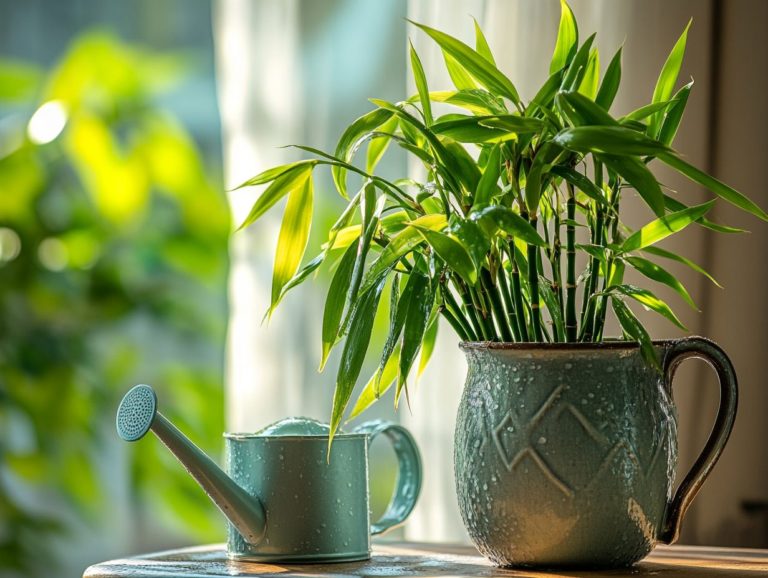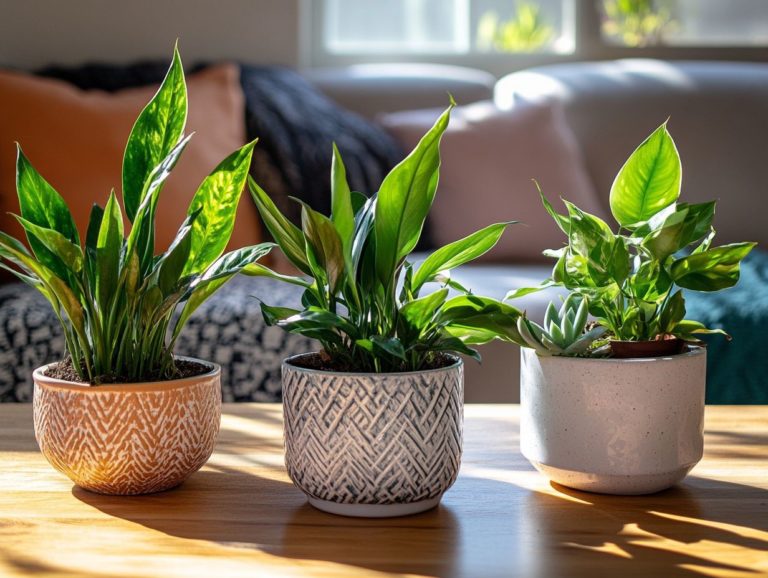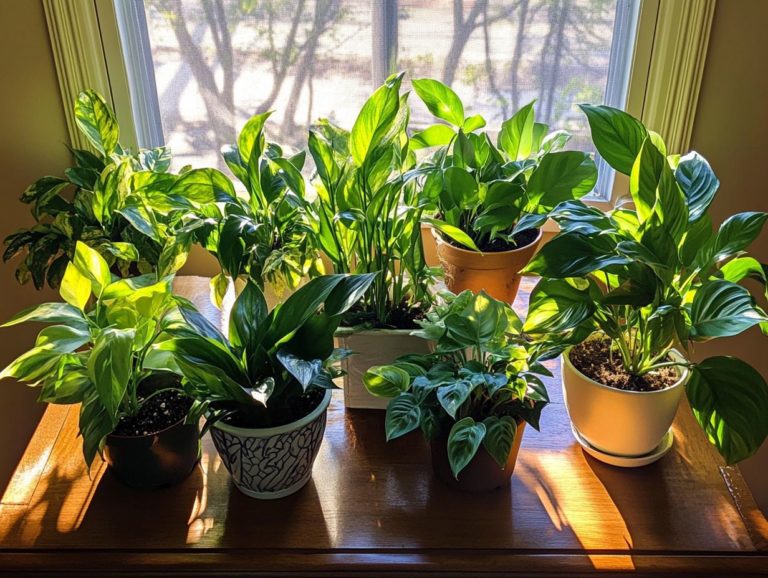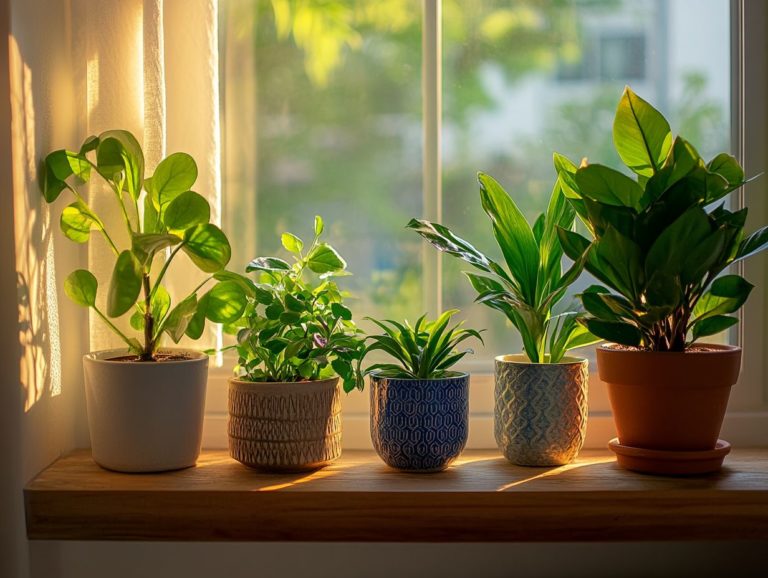Caring for Indoor Petunias: A Complete Guide
Petunias are vibrant, versatile flowers that can effortlessly infuse life into any indoor space. If you re aiming to brighten up your home with these stunning blooms, grasping the right varieties and their specific care requirements is crucial.
This guide walks you through selecting the best petunia types tailored to your environment while ensuring they receive optimal lighting, watering, and nutrition. You ll also find insights on common pests and diseases, along with practical tips for pruning and propagating your plants.
Get ready to create a thriving indoor garden that bursts with color!
Contents
- Key Takeaways:
- Choosing the Right Petunia Varieties for Indoor Care
- Providing Proper Lighting for Indoor Petunias
- Watering and Fertilizing Indoor Petunias
- Pest and Disease Management for Indoor Petunias
- Caring for Indoor Petunias
- Frequently Asked Questions
- Want to keep your indoor petunias thriving? Here are some tips!
- How much sunlight do indoor petunias need to thrive in different climate zones?
- Do indoor petunias require any special fertilizers?
- How often should indoor petunias be watered?
- Can indoor petunias be grown from seeds?
- How should indoor petunias be pruned?
Key Takeaways:
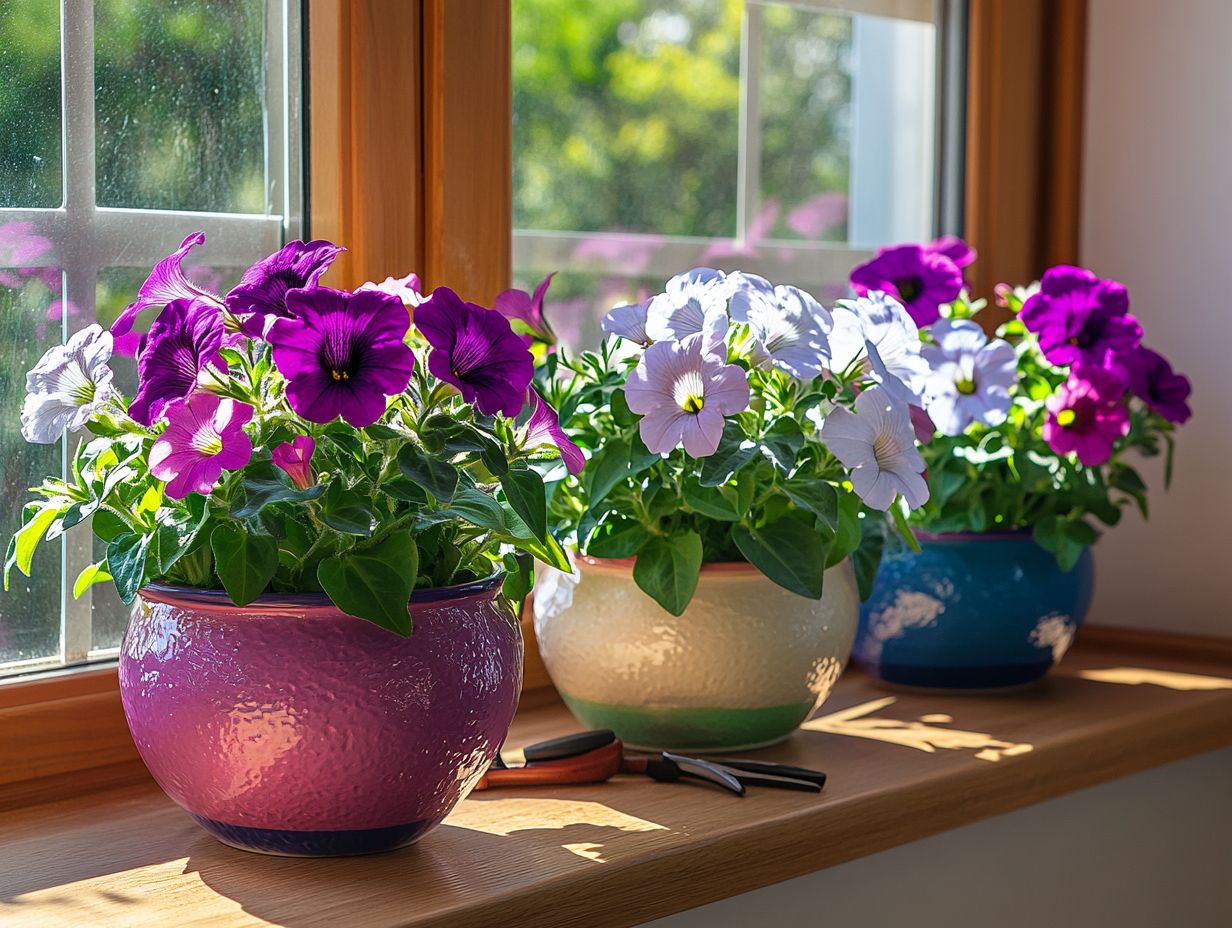
- Choose the right petunia varieties for indoor care by considering factors such as space, lighting, and maintenance, including their soil requirements.
- Provide proper lighting for indoor petunias by understanding their light requirements and using supplemental lighting if needed.
- Maintain healthy indoor petunias by proper watering and fertilizer types practices, and addressing common pests and diseases through prevention and management techniques.
Overview of Petunia Plants
Petunias, particularly Petunia x hybrida, are your go-to vibrant, tender perennials, known for their beautiful flowers and remarkable adaptability to various growing conditions. These beloved flowers are a favorite among gardeners like you, primarily because they thrive in full sun and come in an impressive array of colors and varieties.
By understanding petunia care, including their specific soil requirements and preferred blooming seasons, you can cultivate a flourishing garden that showcases these beautiful blooms all season long.
Among the diverse types, Grandiflora petunias flaunt large, showy flowers that are perfect for making a bold statement. If you prefer something more compact and weather-resistant, the Multiflora varieties are excellent for hanging baskets and garden borders.
For smaller spaces, Milliflora petunias offer delicate blooms that still pack a punch. Don t overlook the popular Supertunia Vista Bubblegum , celebrated for its vigorous growth and resilience.
To achieve optimal growth, ensure you provide well-draining soil, regular watering, and a balanced fertilization schedule. Petunia blooms are significant; they attract pollinators like hummingbirds and add vibrant splashes of color that elevate the aesthetic appeal of any outdoor space.
Choosing the Right Petunia Varieties for Indoor Care
Choosing the right petunia varieties is essential for your indoor gardening success. This ensures that you enjoy vibrant blooms throughout the season. Consider factors like your climate zones and the specific conditions of your indoor space, as these will significantly influence which petunias thrive in container gardening.
Opting for varieties such as trailing petunias can enhance the beauty of your indoor environment, provided you give them the care they require.
Factors to Consider
When choosing petunia varieties for indoor care, it s essential to consider factors like their specific water needs, soil requirements, and the amount of full sun they ll receive in your space. Each petunia variety boasts unique characteristics that dictate how they thrive, making it crucial to align their needs with your indoor gardening conditions.
To ensure optimal growth, select a well-draining soil mix preferably one that includes perlite (a lightweight material that improves drainage) or vermiculite (a mineral that helps retain moisture) to prevent waterlogging.
Watering petunias should generally happen when the top inch of soil feels dry, allowing you to strike the perfect balance between hydration and avoiding root rot. They love bright, indirect sunlight for about 6 to 8 hours daily, so picking the right window placement can truly boost their blooming potential.
By paying attention to these details, you can cultivate vibrant and healthy petunias indoors, transforming any space into a lively floral display.
Start selecting your petunia varieties today and watch your indoor space flourish!
Providing Proper Lighting for Indoor Petunias

Providing the right lighting is essential for the health and vitality of your indoor petunias. These flowers thrive in bright light, ensuring a vibrant blooming season.
Understanding the specific light requirements for petunia varieties enhances their growth. This promotes lush foliage and an abundance of stunning flowers.
Understanding Light Requirements
Petunias, known as sun-loving plants, thrive in full sun exposure. This is crucial for best growth and vibrant blooms.
Check the variety of petunia you have, as some tolerate partial shade. For example, certain hybrids may thrive with just four hours of direct sunlight daily, while others require six to eight hours.
When arranging your plants, observe how light filters through your windows. Direct sunlight is strong and unfiltered, while indirect light is softer and gentler.
Establish a rotation schedule for your petunias to maximize light exposure. This ensures they enjoy the best growing conditions.
Watering and Fertilizing Indoor Petunias
Watering and fertilizing your indoor petunias accurately is crucial for their growth. This care profoundly impacts their flowering performance.
By understanding the ideal watering frequency and choosing the best fertilizers, you’ll create the perfect environment for vibrant petunias.
Best Practices for Watering and Feeding
Implementing best practices for watering and feeding keeps your indoor petunias healthy and vibrant. Knowing the right watering frequency helps avoid overwatering and nutrient deficiencies.
To maintain optimal moisture, regularly check the top inch of the soil. It should feel slightly dry before you water again.
Select a water-soluble fertilizer designed for flowering plants. During the active growing season, apply it every two to four weeks for lush growth and abundant blooms.
Pest and Disease Management for Indoor Petunias
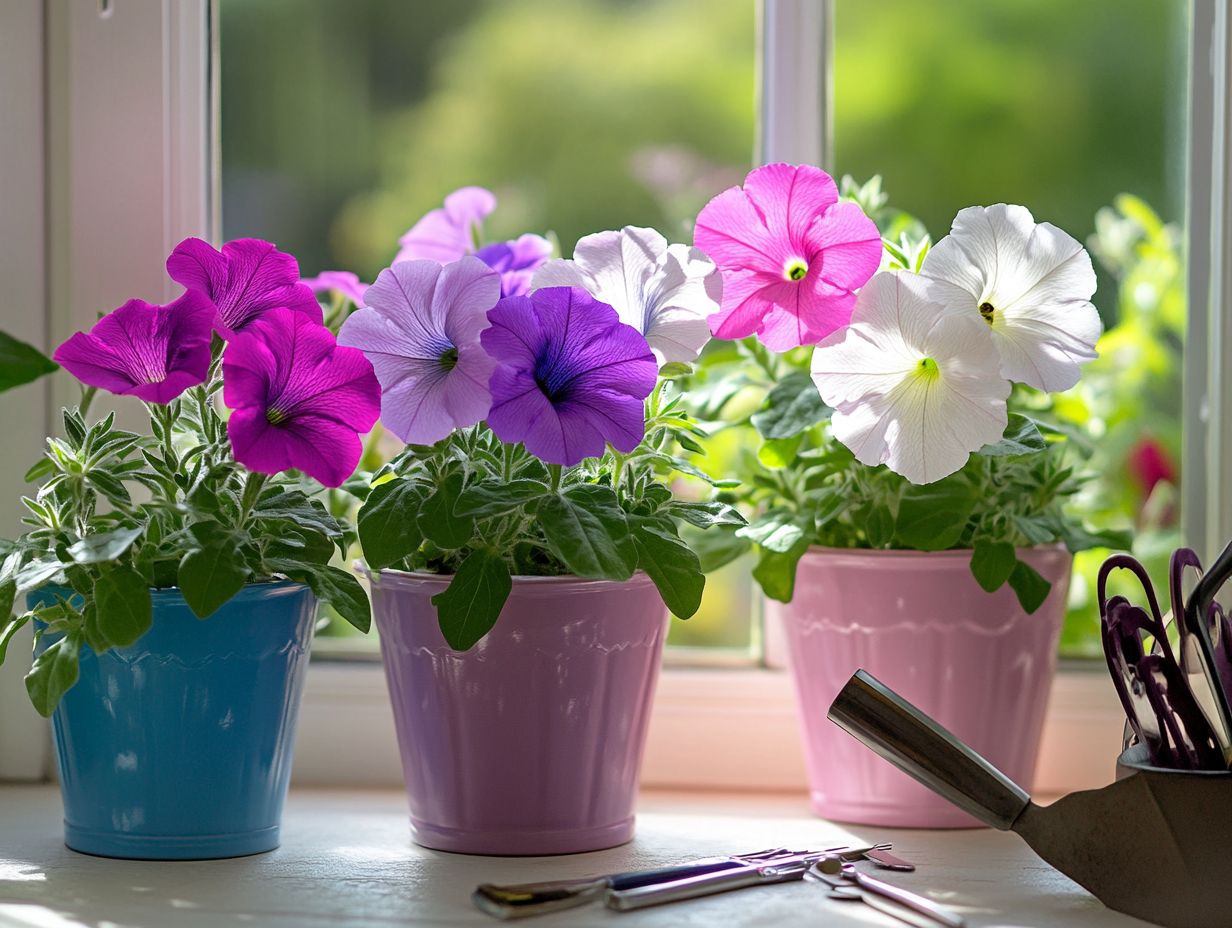
Effective pest and disease management is vital for your indoor petunias. These delicate flowers can face threats from pests like aphids and issues like root rot or Botrytis blight, a fungal disease.
Recognizing common threats and taking preventive measures ensures your indoor petunias stay healthy and vibrant.
Common Issues and Solutions
Indoor petunias often face common challenges, including problems from slugs and snails and diseases that can hinder their growth. It’s crucial to implement great solutions to keep them healthy and happy!
Recognizing the signs of these threats is essential. For example, look for large, irregular holes in the leaves, which can indicate slug activity. Meanwhile, powdery mildew may appear as a white, powdery fungus on the foliage.
To tackle these issues, consider embracing natural remedies such as:
- Setting out shallow dishes filled with beer to attract and drown those troublesome slugs.
- Using neem oil, a natural oil that helps keep pests away, to deter a wide range of pests.
Maintaining well-drained soil and ensuring proper air circulation can significantly reduce the risk of diseases. These straightforward yet effective strategies not only protect your plants’ health but also promote a more sustainable approach to gardening.
Caring for Indoor Petunias
Pruning and propagating indoor petunias are essential techniques that enhance their growth and longevity, making them key components of petunia care.
With proper pruning, you not only encourage bushier growth but also maintain the overall health of the plant. Effective propagation methods enable you to expand your collection of these exquisite flowers, allowing you to enjoy their beauty even more.
Techniques for Maintaining and Propagating Plants
Techniques for maintaining and propagating indoor petunias are essential for elevating your gardening experience. This ensures vibrant blooms and robust growth throughout the season.
To start, proper watering practices and understanding their water needs are crucial. Allow the soil to dry out slightly between waterings to prevent root rot think of it as giving your petunias a well-deserved breather. Providing adequate sunlight ideally six hours of bright, indirect light will set the stage for these colorful blooms to truly thrive.
For propagation, utilizing stem cuttings and other propagation methods can yield remarkable results, especially when paired with a rooting hormone, a substance that encourages plants to grow roots, to promote swift growth. Alternatively, you can sow seeds directly into nutrient-rich soil, making sure to space them properly to avoid overcrowding so all your petunia varieties thrive.
Each method has its own nuances, including understanding soil requirements. Grasping these details can lead to an impressive indoor petunia display that will delight you throughout the blooming season.
Frequently Asked Questions
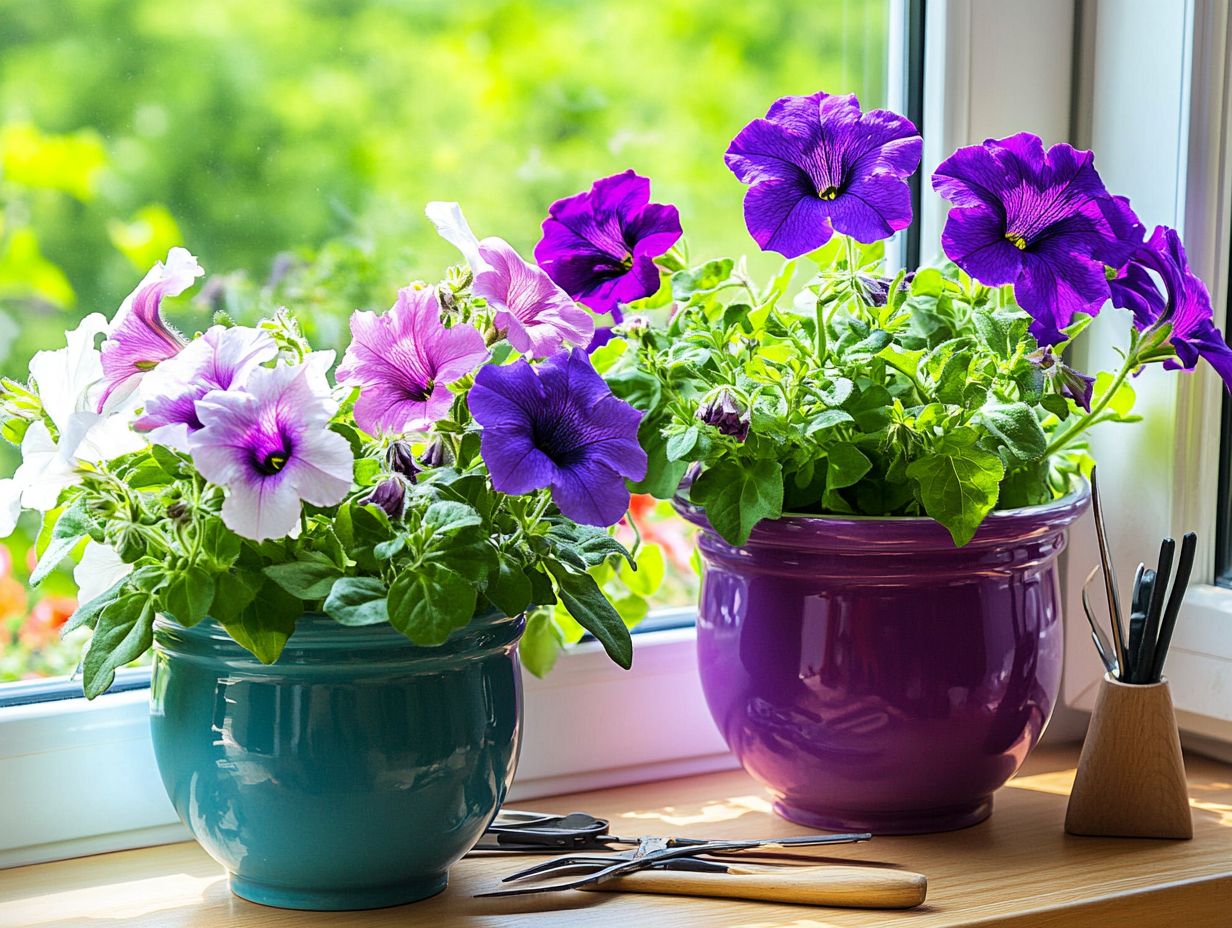
Want to keep your indoor petunias thriving? Here are some tips!
Some important care tips include providing adequate sunlight, keeping them in a well-draining potting mix, and watering regularly.
How much sunlight do indoor petunias need to thrive in different climate zones?
Indoor petunias need at least six hours of sunlight per day, so place them near a window that receives direct sunlight.
Do indoor petunias require any special fertilizers?
Indoor petunias do not need special fertilizers, but you can use a balanced fertilizer, considering the different fertilizer types, once every two weeks to promote healthy growth.
How often should indoor petunias be watered?
Water indoor petunias when the top inch of the soil feels dry to the touch. Avoid overwatering, as it can cause root rot.
Can indoor petunias be grown from seeds?
Yes, indoor petunias can be grown from seeds. However, they take longer to bloom compared to established Petunia plants.
How should indoor petunias be pruned?
Regularly pruning petunias helps maintain their beauty, promoting healthy growth and preventing legginess. Pinch off any dead or wilted flowers and trim long stems to encourage bushier growth, a technique known as deadheading petunias.

